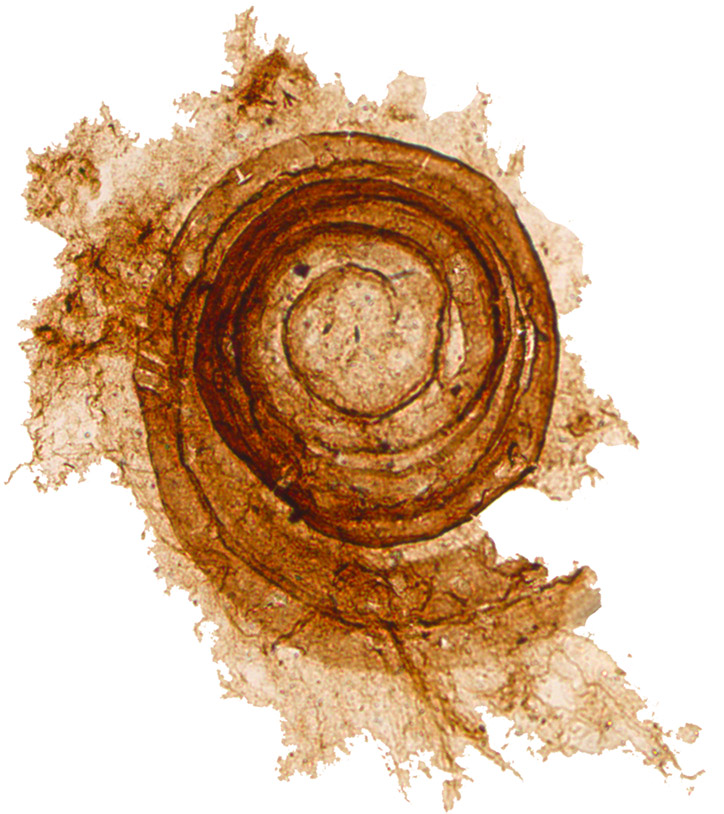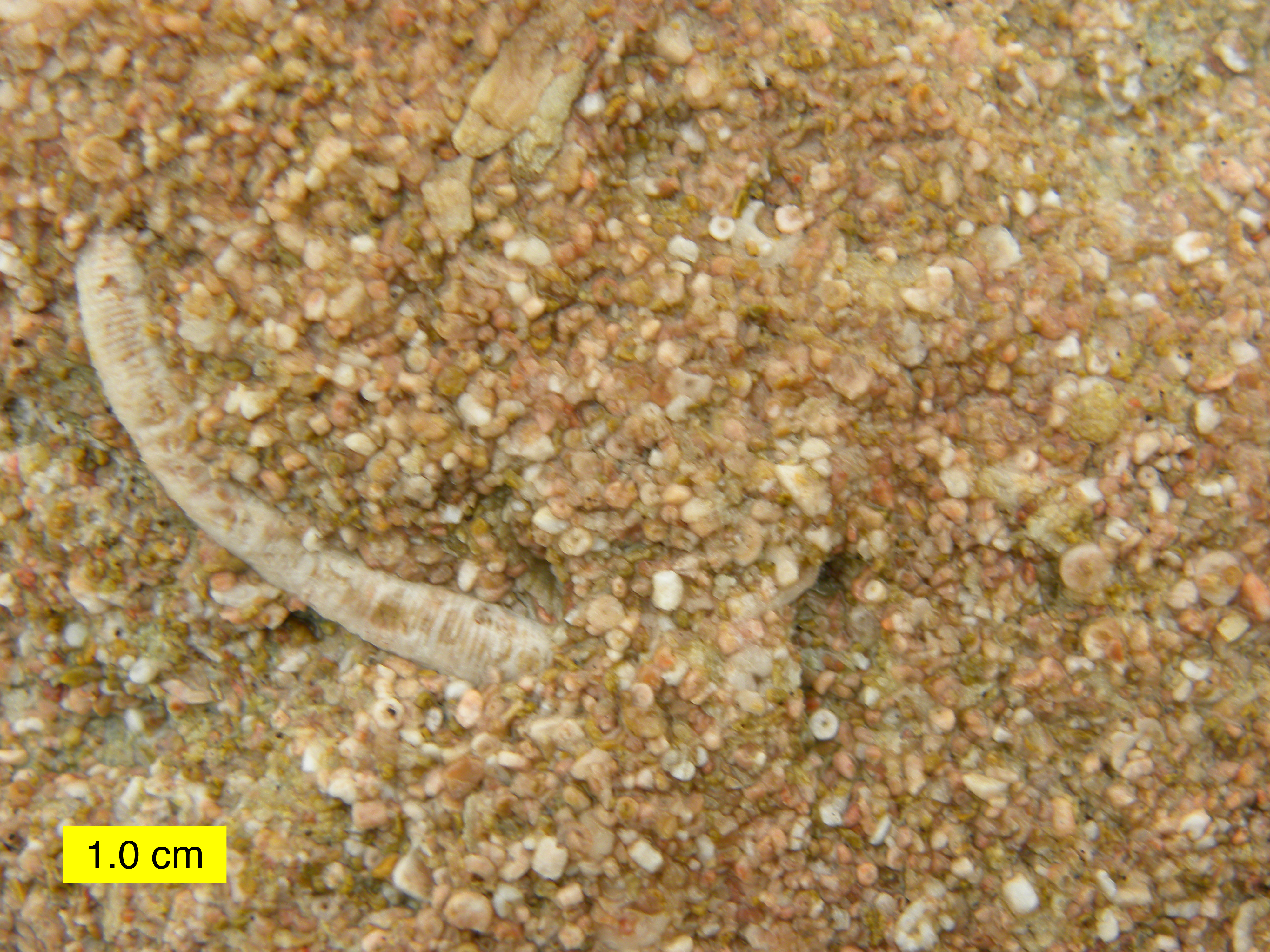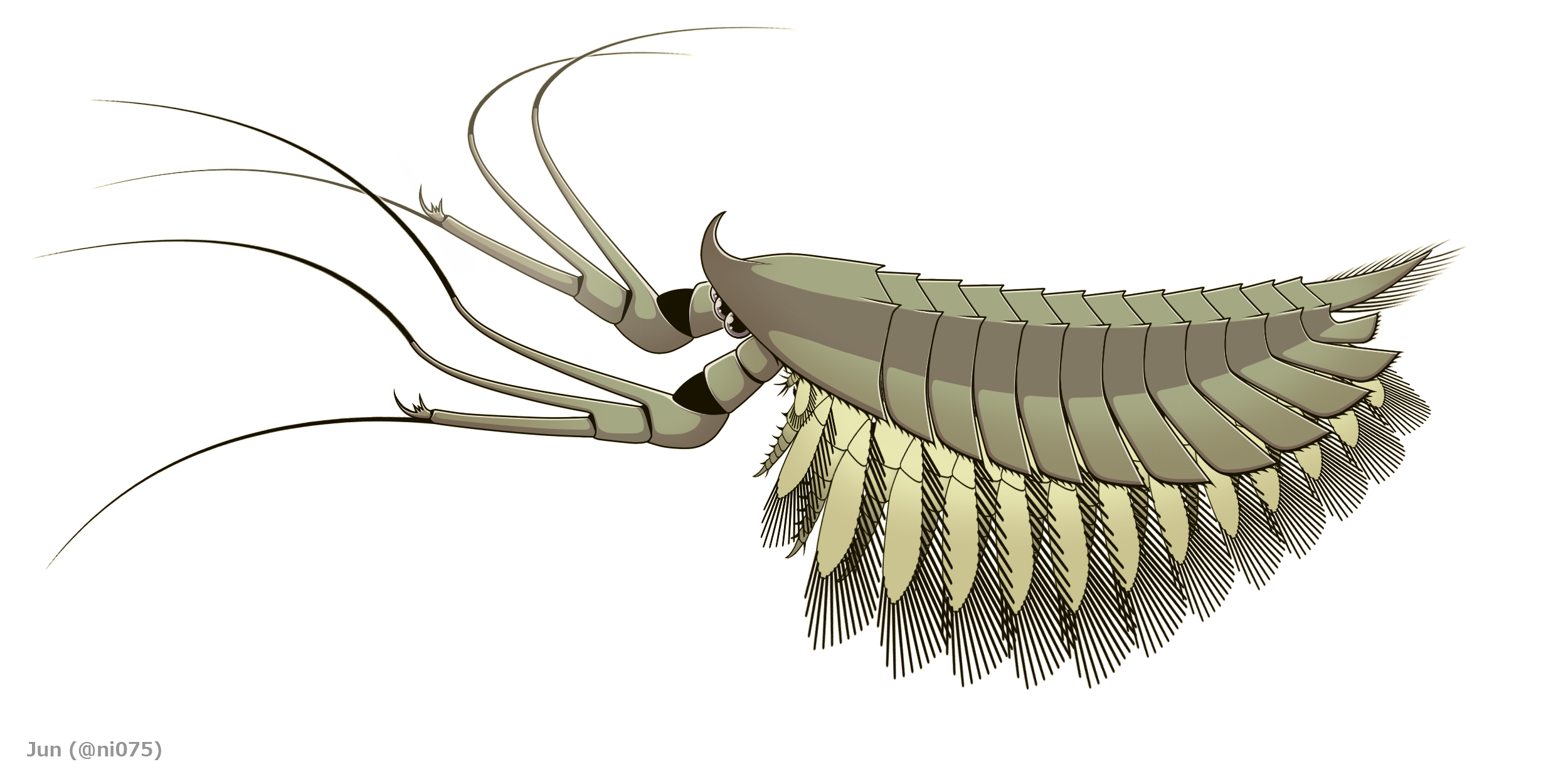|
Phosphatisation
Phosphatic fossilization has occurred in unusual circumstances to preserve some extremely high-resolution microfossils in which careful preparation can even reveal preserved cellular structures. Such microscopic fossils are only visible under the scanning electron microscope. Mechanism Large quantities of phosphate are required, either from seawater or from the tissues of the decaying organism. In some cases microbes control the phosphatization, and the remains of the microbes that fed on the preserved tissue form the fossil. In other, the tissue itself is the source of phosphate and its phosphatized remains form the fossil. In the intermediate case the phosphatized tissue retains the impressions of the phosphatizing microbes. Phosphatic preservation in Burgess Shale-type fossils Soft-tissue fossils, such as those found in the Burgess Shale, are rare. In some cases their internal organs are replicated in phosphate. The phosphate mainly comes from the tissue itself, and may late ... [...More Info...] [...Related Items...] OR: [Wikipedia] [Google] [Baidu] |
Microfossils
A microfossil is a fossil that is generally between 0.001 mm and 1 mm in size, the visual study of which requires the use of light or electron microscopy. A fossil which can be studied with the naked eye or low-powered magnification, such as a hand lens, is referred to as a macrofossil. Microfossils are a common feature of the geological record, from the Precambrian to the Holocene. They are most common in deposits of marine environments, but also occur in brackish water, fresh water and terrestrial sedimentary deposits. While every kingdom of life is represented in the microfossil record, the most abundant forms are protist skeletons or microbial cysts from the Chrysophyta, Pyrrhophyta, Sarcodina, acritarchs and chitinozoans, together with pollen and spores from the vascular plants. Overview A microfossil is a descriptive term applied to fossilized plants and animals whose size is just at or below the level at which the fossil can be analyzed by the naked eye ... [...More Info...] [...Related Items...] OR: [Wikipedia] [Google] [Baidu] |
Doushantuo Formation
The Doushantuo Formation (formerly transcribed as Toushantuo or Toushantou, from ) is a geological formation in western Hubei, eastern Guizhou, southern Shaanxi, central Jiangxi, and other localities in China. It is known for the fossil Lagerstätten in Zigui in Hubei, Xiuning in Anhui, and Weng'an in Guizhou, as one of the oldest beds to contain minutely preserved microfossils, phosphatic fossils that are so characteristic they have given their name to "Doushantuo type preservation". The formation, whose deposits date back to the Early and Middle Ediacaran, is of particular interest because it covers the poorly understood interval of time between the end of the Cryogenian geological period and the more familiar fauna of the Late Ediacaran Avalon explosion, as well as due to its microfossils' potential utility as biostratigraphical markers. Taken as a whole, the Doushantuo Formation ranges from about 635 Ma (million years ago) at its base to about 551 Ma at its top, ... [...More Info...] [...Related Items...] OR: [Wikipedia] [Google] [Baidu] |
Grainstone
Under the Dunham classification (Dunham, 1962) system of limestones, a grainstone is defined as a grain-supported carbonate rock that contains less than 1% mud-grade material. This definition has recently been clarified as ''a carbonate-dominated rock that does not contain any carbonate mud and where less than 10% of the components are larger than 2 mm.'' The spaces between grains may be empty (pores) or filled by cement. The identification of grainstone The presence of any primary carbonate mud precludes a classification of grainstone. A study of the use of carbonate classification systems by Lokier and Al Junaibi (2016) highlighted that the most common source of confusion in the classification of grainstone was to misidentify fine-grained internal micrite, generated by in-situ processes, as clay–silt grade sediment - thus resulting in the misidentification of grainstone as packstone Under the Dunham classification (Dunham, 1962Dunham, R.J. (1962) Classification of carbonate ... [...More Info...] [...Related Items...] OR: [Wikipedia] [Google] [Baidu] |
Fluorapatite
Fluorapatite, often with the alternate spelling of fluoroapatite, is a phosphate mineral with the formula Ca5(PO4)3F (calcium fluorophosphate). Fluorapatite is a hard crystalline solid. Although samples can have various color (green, brown, blue, yellow, violet, or colorless), the pure mineral is colorless, as expected for a material lacking transition metals. Along with hydroxylapatite, it can be a component of tooth enamel, but for industrial use both minerals are mined in the form of phosphate rock, whose usual mineral composition is primarily fluorapatite but often with significant amounts of the other. Fluorapatite crystallizes in a hexagonal crystal system. It is often combined as a solid solution with hydroxylapatite (Ca5(PO4)3OH or Ca10(PO4)6(OH)2) in biological matrices. Chlorapatite (Ca5(PO4)3Cl) is another related structure. Industrially, the mineral is an important source of both phosphoric and hydrofluoric acids. Fluorapatite as a mineral is the most common p ... [...More Info...] [...Related Items...] OR: [Wikipedia] [Google] [Baidu] |
Blastula
Blastulation is the stage in early animal embryonic development that produces the blastula. In mammalian development the blastula develops into the blastocyst with a differentiated inner cell mass and an outer trophectoderm. The blastula (from Greek '' βλαστός'' ( meaning ''sprout'')) is a hollow sphere of cells known as blastomeres surrounding an inner fluid-filled cavity called the blastocoel. Embryonic development begins with a sperm fertilizing an egg cell to become a zygote, which undergoes many cleavages to develop into a ball of cells called a morula. Only when the blastocoel is formed does the early embryo become a blastula. The blastula precedes the formation of the gastrula in which the germ layers of the embryo form. A common feature of a vertebrate blastula is that it consists of a layer of blastomeres, known as the blastoderm, which surrounds the blastocoel. In mammals, the blastocyst contains an embryoblast (or inner cell mass) that will eventually give ri ... [...More Info...] [...Related Items...] OR: [Wikipedia] [Google] [Baidu] |
Metazoan
Animals are multicellular, eukaryotic organisms in the biological kingdom Animalia. With few exceptions, animals Heterotroph, consume organic material, Cellular respiration#Aerobic respiration, breathe oxygen, are Motility, able to move, can Sexual reproduction, reproduce sexually, and go through an ontogenetic stage in which their body consists of a hollow sphere of Cell (biology), cells, the blastula, during Embryogenesis, embryonic development. Over 1.5 million Extant taxon, living animal species have been Species description, described—of which around 1 million are Insecta, insects—but it has been estimated there are over 7 million animal species in total. Animals range in length from to . They have Ecology, complex interactions with each other and their environments, forming intricate food webs. The scientific study of animals is known as zoology. Most living animal species are in Bilateria, a clade whose members have a Symmetry in biology#Bilateral symmetry, bilat ... [...More Info...] [...Related Items...] OR: [Wikipedia] [Google] [Baidu] |
Ediacaran
The Ediacaran Period ( ) is a geological period that spans 96 million years from the end of the Cryogenian Period 635 million years ago (Mya), to the beginning of the Cambrian Period 538.8 Mya. It marks the end of the Proterozoic Eon, and the beginning of the Phanerozoic Eon. It is named after the Ediacara Hills of South Australia. The Ediacaran Period's status as an official geological period was ratified in 2004 by the International Union of Geological Sciences (IUGS), making it the first new geological period declared in 120 years. Although the period takes its name from the Ediacara Hills where geologist Reg Sprigg first discovered fossils of the eponymous Ediacaran biota in 1946, the type section is located in the bed of the Enorama Creek within Brachina Gorge in the Flinders Ranges of South Australia, at . The Ediacaran marks the first appearance of widespread multicellular fauna following the end of Snowball Earth glaciation events, the so-called Ediacaran biota, ... [...More Info...] [...Related Items...] OR: [Wikipedia] [Google] [Baidu] |
Cephalopod
A cephalopod is any member of the molluscan class Cephalopoda (Greek plural , ; "head-feet") such as a squid, octopus, cuttlefish, or nautilus. These exclusively marine animals are characterized by bilateral body symmetry, a prominent head, and a set of arms or tentacles (muscular hydrostats) modified from the primitive molluscan foot. Fishers sometimes call cephalopods "inkfish", referring to their common ability to squirt ink. The study of cephalopods is a branch of malacology known as teuthology. Cephalopods became dominant during the Ordovician period, represented by primitive nautiloids. The class now contains two, only distantly related, extant subclasses: Coleoidea, which includes octopuses, squid, and cuttlefish; and Nautiloidea, represented by ''Nautilus'' and ''Allonautilus''. In the Coleoidea, the molluscan shell has been internalized or is absent, whereas in the Nautiloidea, the external shell remains. About 800 living species of cephalopods have been ident ... [...More Info...] [...Related Items...] OR: [Wikipedia] [Google] [Baidu] |
Arthropod
Arthropods (, (gen. ποδός)) are invertebrate animals with an exoskeleton, a Segmentation (biology), segmented body, and paired jointed appendages. Arthropods form the phylum Arthropoda. They are distinguished by their jointed limbs and Arthropod cuticle, cuticle made of chitin, often Mineralization (biology), mineralised with calcium carbonate. The arthropod body plan consists of segments, each with a pair of appendages. Arthropods are bilaterally symmetrical and their body possesses an exoskeleton, external skeleton. In order to keep growing, they must go through stages of moulting, a process by which they shed their exoskeleton to reveal a new one. Some species have wings. They are an extremely diverse group, with up to 10 million species. The haemocoel, an arthropod's internal cavity, through which its haemolymph – analogue of blood – circulates, accommodates its interior Organ (anatomy), organs; it has an open circulatory system. Like their exteriors, the internal or ... [...More Info...] [...Related Items...] OR: [Wikipedia] [Google] [Baidu] |
Leanchoilia
''Leanchoilia'' is an megacheiran arthropod known from Cambrian deposits of the Burgess Shale in Canada and the Chengjiang biota of China. It was about long and had long, whip-like feelers mounted on frontal arm-like appendages. Its internal organs are occasionally preserved within the substrate in three dimensions. Seven species are tentatively accepted today: ''L. superlata'' (the type species), ''L. persephone'' and ''L. protogonia'' from the Burgess Shale, ''L. illecebrosa'' and ''L. obesa'' from the Chengjiang biota, 'L. robisoni'' from Kaili, and ''L.''? ''hanceyi'' from the Spence Shale. ''L. superlata'' and ''L. persephone'' may however be examples of sexual dimorphism. 55 specimens of ''Leanchoilia'' are known from the Greater Phyllopod bed The Phyllopod bed, designated by USNM locality number 35k, is the most famous fossil-bearing member of the Burgess Shale fossil ''Lagerstätte''. It was quarried by Charles Walcott from 1911–1917 (and later named Walcott Q ... [...More Info...] [...Related Items...] OR: [Wikipedia] [Google] [Baidu] |



.jpg)


.jpg)

